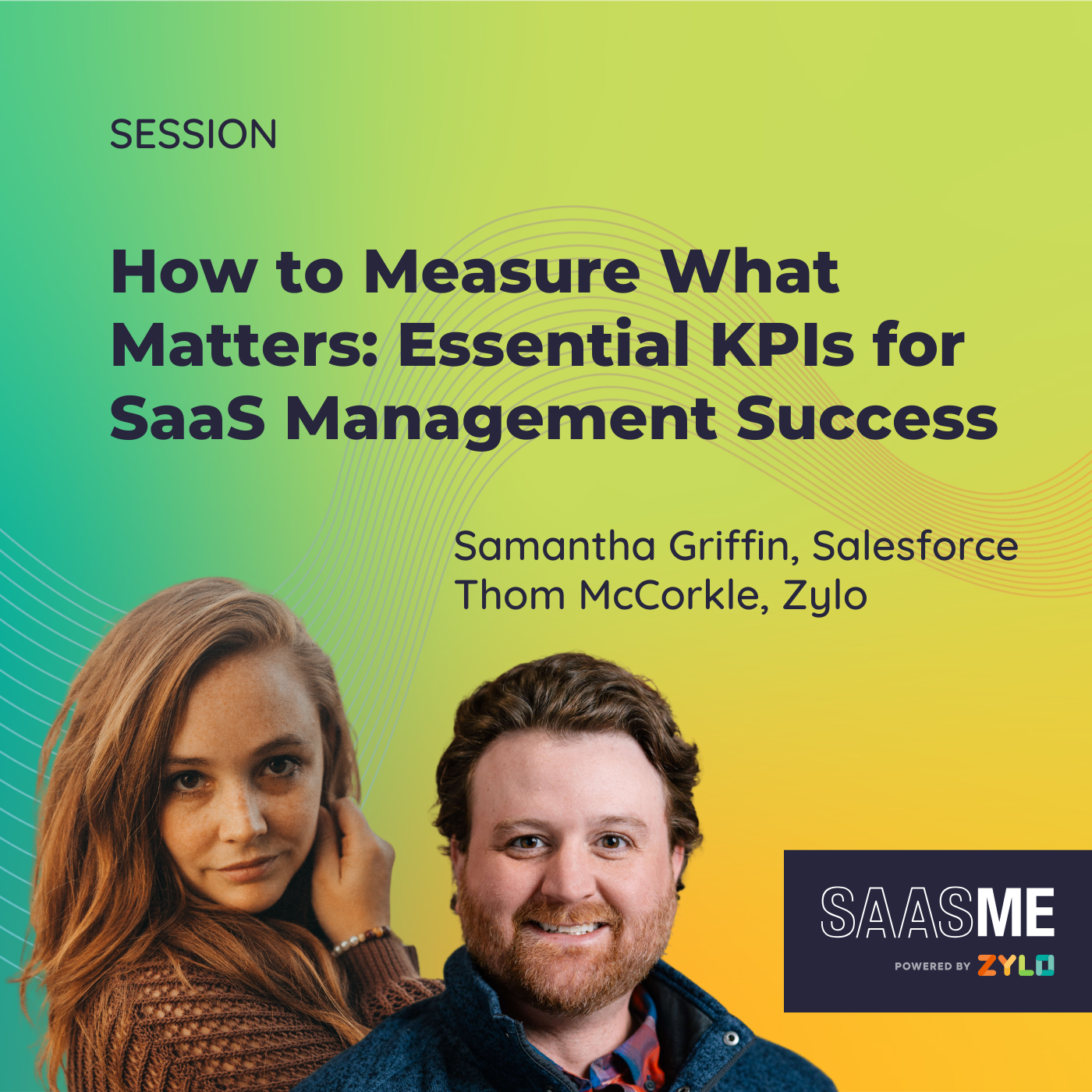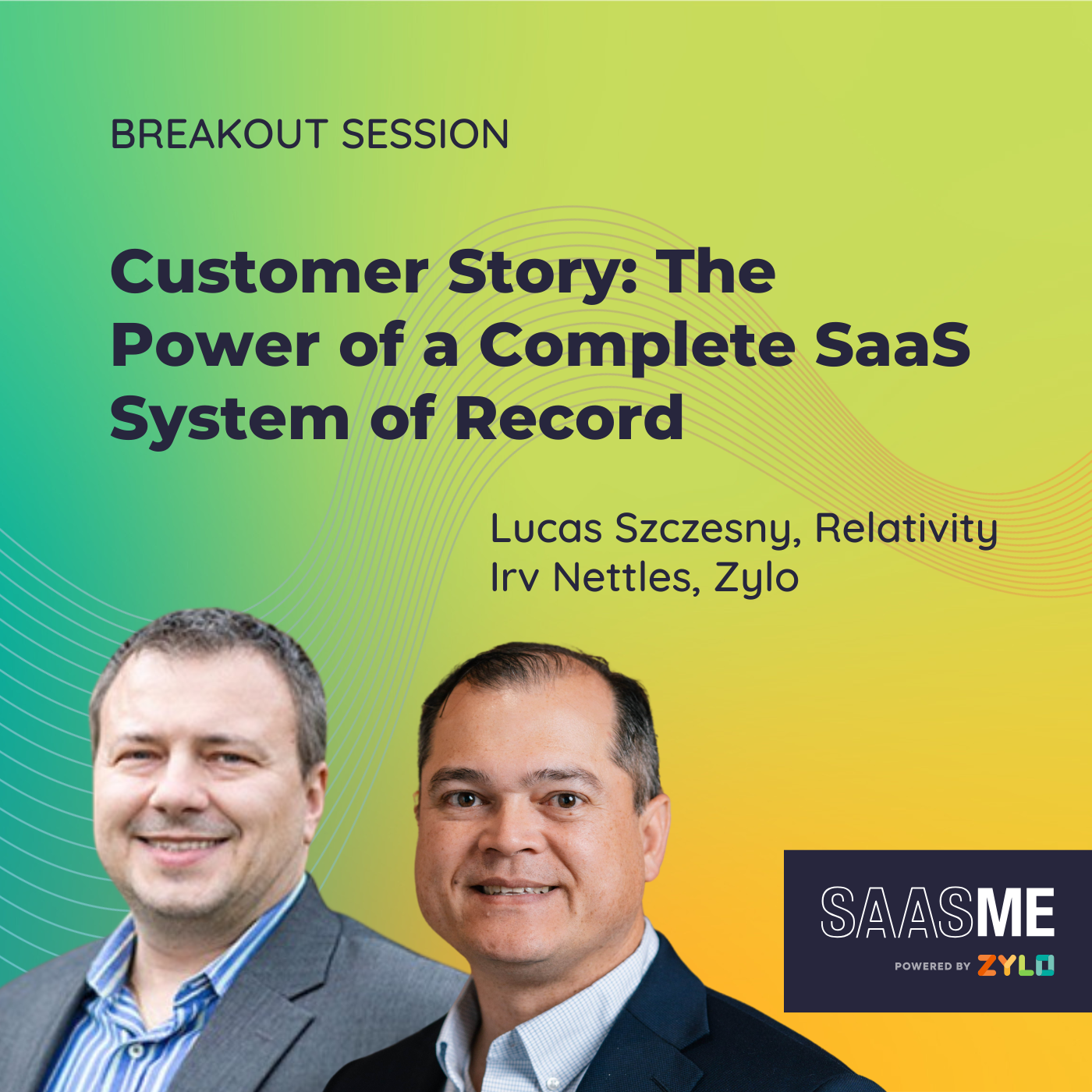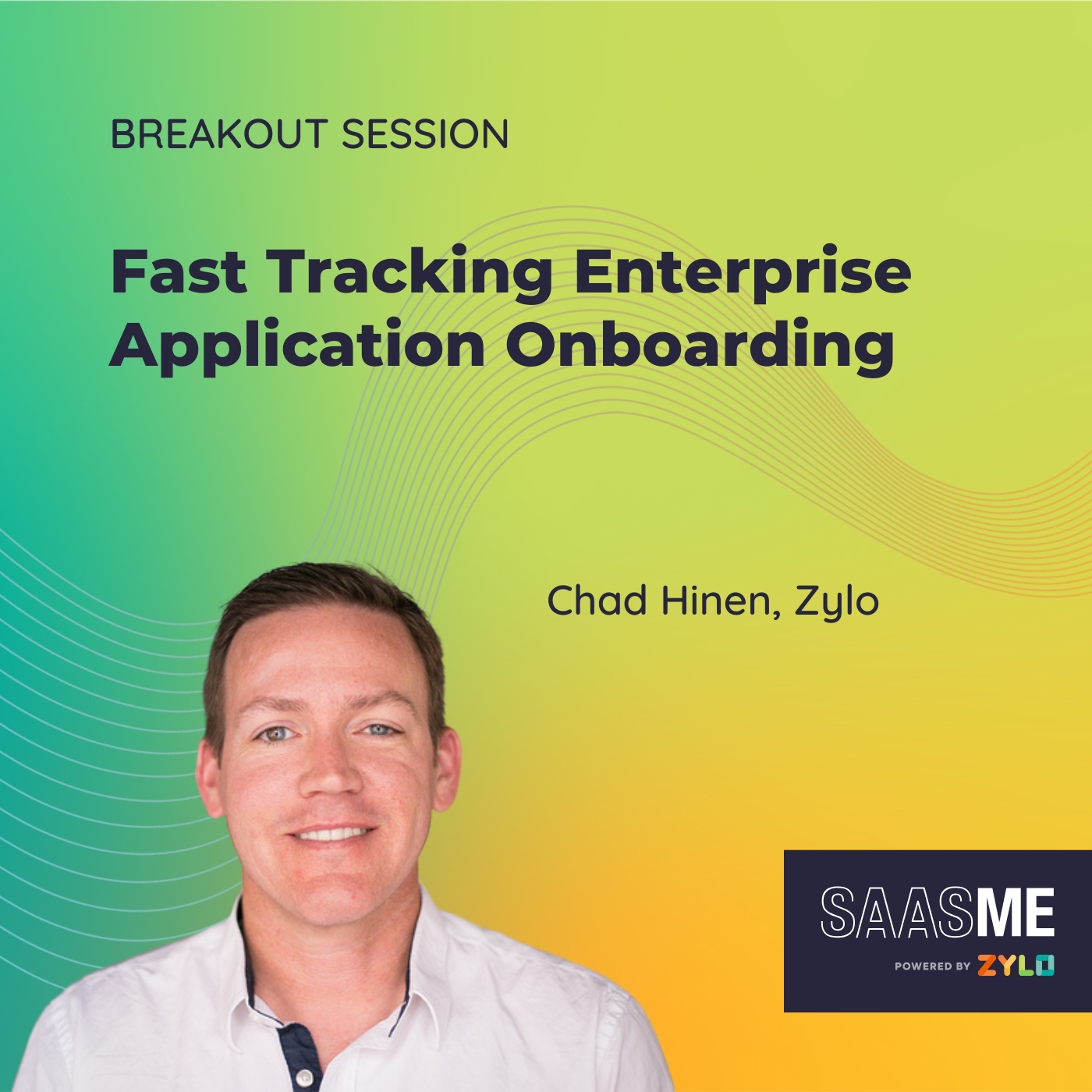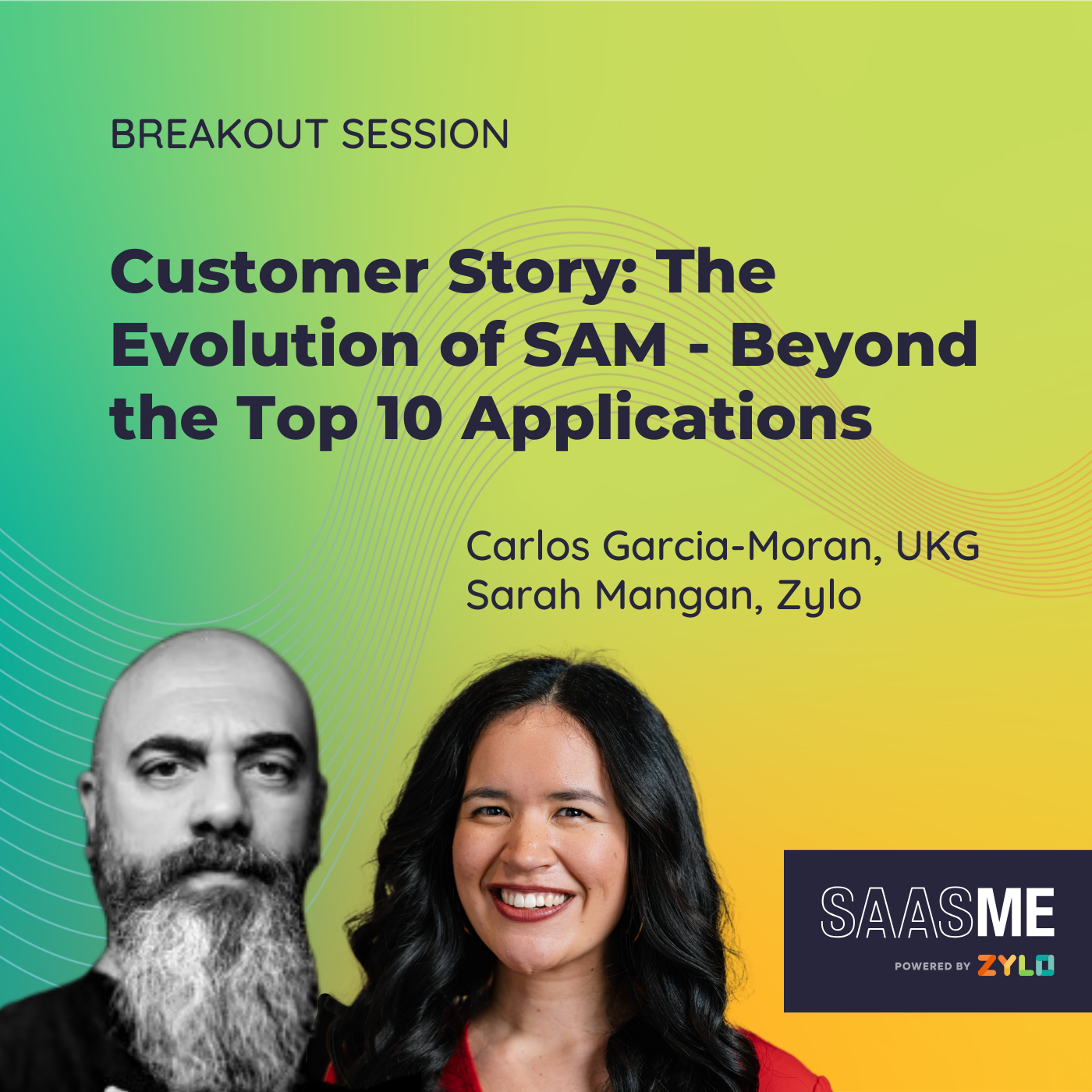Partnering with IT to Become a Force Multiplier
- 0.5
- 1
- 1.25
- 1.5
- 1.75
- 2
Brittney Linville: Hi, everybody. How is SaaSMe going for you? I hope you're able to join a bunch of different sessions and learn a lot of different things about SaaS management. I know the team's put together a lot of great content, and I hope you're taking a moment to absorb all of it. My session that we're going to talk about here today is how a really strong partnership between procurement and IT can become a force multiplier for your organization. My name is Brittney Linville. I'm a strategic account executive here at Zylo, but I've walked a mile in your shoes. I'm a former customer of Zylo, and I've spent the majority of my career in procurement, collaborating with IT teams and other business functions to help align a SaaS management program, drive down costs, get efficiencies within the organization, and really try to wrap your head around what you actually have in your environment. So I want to walk you through some key things that I've learned in my career, but as well some best practices from other Zylo clients that have world- class SaaS management programs, and give you some tips, some tricks, and maybe talk to you about why having a tighter relationship with your IT teams can really help produce some better outcomes. So for today's session, we're going to focus on some key areas that really outline why having that strong relationship as a procurement professional with your IT stakeholders and other technical business contacts across the organization can help drive better outcomes within your SaaS management program. We're going to start talking about some common challenges. When we don't have these teams aligned, what do you see? What happens in those scenarios? Then we're going to discuss the type of outcomes that can be better achieved when those teams partner together, and we're going to leverage an outcomes blueprint that can kind of help you visualize what you can drive, how you can get there, and some key tactics that you can implement by leveraging the Zylo platform in order to drive towards that big objective that you want to achieve. Then we're going to provide some real- world examples for you of how teams can work together, and then wrap it up with some key takeaways that you could implement today in your business and help drive better outcomes and better decisions within your SaaS management program. So let's go ahead and get started.
Brittney Linville: I remember my time in the not too distant past where I came in as a procurement leader to an organization. Procurement wasn't a core function before I had arrived, and I recall seeing a few key areas, and these may resonate with you, if there's not a strong partnership between your procurement organization and your IT department when it comes to your SaaS renewals. Without a strong relationship, it can lead to procurement teams having blind renewals. You don't know what things are being used for, who's using them, who's managing them, or even if it's driving outcomes that your organization cares about. But you and the procurement team, you get a renewal alert. You don't want to miss the renewal and potentially have something get canceled by a supplier and then it brings down a critical component of your business operations. So you renew, but you're not confident that that was the right step to take or maybe that you're not confident that the business actually needed that. You end up renewing what you don't need. When you don't have a strong partnership, procurement doesn't have a way of knowing if the licenses you purchased are actually being used in the business, or even if that app is really being used by teams in their day- to- day business, or did they buy a new app and everybody moved over to that other one? So you may renew, but you may also be spending on things that are no longer needed, and that directly leads into overspending. This is because without the right data, you can't rightsize the application before it renews or rationalize it against other similar functionality within the portfolio. So you're not renewing with confidence, you're renewing based on assumptions like, " Oh, well, we expect this to grow in alignment with our headcount," or we expect the price to increase this year, but you don't have that data that makes you feel really good and confident that the renewal was really the best you could do for the organization.
Brittney Linville: So what does this lead to when there's not alignment between procurement and IT teams? We're really seeing in the research that's conducted in the annual SaaS Management Index that SaaS spend is increasing and companies are spending more and more on existing tools. This is leading to increases not only in the overall spend but in the proliferation of applications and the average cost it takes for each employee to support them with the software they need to do their job. People are spending more on existing tools. Some other trends that we're seeing is, vendor price increases are on the rise. Everybody's incorporating AI and premium functionality within their applications, so you're starting to see those prices tick up. As I mentioned, AI spending is increasing very greatly each and every year because more and more tools are coming to market and we're seeing a lot of people purchasing those and also coming through expense processes. That leads to decentralization as more and more apps are getting onboarded that may not have gone through official processes or they're outside of that centralized managed framework within an organization. We're also seeing a lot of teams lean towards single- year contracts. That makes more work every year for a procurement team, but the reason they're doing that, they don't want to be locked in with vendors long- term. They don't want to be locked into assumptions long- term.
Brittney Linville: But there's also a larger issue that we're seeing in trends in the marketplace. By not having a strong partnership between procurement and IT, it is leading to tremendous amounts of license waste. We're seeing license waste across all sizes of business. But in large enterprises, so those organizations that have 10,000 or more employees, they're not using 45% of the licenses that they're purchasing, and that equates to an average about of$ 127 million of wasted spend annually. These licensing models are getting more complex, and there's a rise of AI and a greater shift toward consumption- based applications. But what could your business do with an extra$ 127 million? That could potentially mean new hires or new product innovations. I mean, there's so many better ways that that$ 127 million could be spent other than unused software licenses or unused SaaS applications. So having alignment between procurement and IT can help bring better oversight to the license utilization.
Brittney Linville: But let's talk about a few other key areas that a strong relationship between these departments can produce. The primary objective that's most frequently cited for the need for a great relationship between procurement and IT is to really have more data- driven SaaS procurement practices. That can be in your renewal processes when you're evaluating net new vendors and SaaS providers, or even with true- ups. That key objective kind of gets its focus and produces four key outcome areas. It gives you better visibility into your inventory and the insights that it produces. It helps you avoid those unnecessary and preventable costs within your SaaS portfolio, which really generates those realized hard cost savings that most procurement teams care a lot about. But one other thing it does is, it helps you have a continuously maintained record of compliance for your SaaS portfolio. This can come into play with those true- ups that we just mentioned, understanding what you've purchased, what's been provisioned. Then there's some key tactics that tie into each of these outcomes. These tactics are things that you can partner with your IT organization to execute on to help you have a better managed SaaS portfolio. So you can see, like with inventory visibility and insights, you can do identification of app redundancy that a lot of procurement teams care about, or that license optimization to help avoid those preventable costs, or really building that key renewal execution strategy by reducing your license prices at renewal and negotiating better prices to drive those realized hard cost savings. But I wanted to focus on some primary ones that are enhanced when there's a strong relationship between a procurement team and your IT organization because there's a couple of key things that can really bring it real world for you and show how powerful that collaboration can be in driving those outcomes.
Brittney Linville: So let's talk about a few of them. I want to start with three key ways that they can work better together, but I want to start with true- ups. A lot of SaaS providers out there that are license- based have a true- up model in them where you purchase a certain number of licenses, but they don't put a hard cap on the number of licenses that you can have throughout the year. So when you exceed that cap by provisioning more people than what you had purchased, they're going to send you another invoice. The reason why this matters in having such a key relationship with your IT team when you have true- up SaaS providers is you want to avoid unexpected costs from those unmanaged licenses. Nobody wants another invoice during the year especially if it's unbudgeted because now you're in a situation where you have to pull money from other parts of the business to cover the overspending when you really wanted to stay on top of that and not see that invoice come in. You can collaborate with IT to understand the actual SaaS usage and reallocate licenses ahead of those true- up events. By proactively getting that usage data, you can forecast and budget effectively so you can spend money on other areas of the business and not on more SaaS licenses. There's several ways that you can partner to get this utilization information from your IT team. We have the ability to rationalize it in Zylo based on your single sign- on information, direct integrations, or our usage connect functionality. This is another reason that the relationship and the partnership is so important, because it's often going to be your IT team that can tell you what's the most reliable usage information that we can use to help plan for and prevent those avoidable costs. Because a great example is, you can think that an application is behind SSO and it's SSO- enforced, and so when you're seeing no activity in Zylo for an application and SSO is your source of usage information, you could say, " Great, all these people that haven't logged in the past 30 days, we're going to take those licenses back." But if you don't validate with your IT team first, they may not require people to re- authenticate into that app via SSO for 45 days. So you may have had somebody that's been logging in, but it's not being captured by that SSO metric because they hadn't logged in the last 30 days multiple times because of that SSO setting. But you in procurement, you're not going to know that without that collaboration and you may deprovision someone's license for a tool that they need and that they're using every day. So it's really key that you partner with your IT team so that you don't make assumptions to deprovision licenses ahead of a true- up event. You can use that usage information and find that best source of truth and get that in and attached to that application in Zylo. Then you can use that utilization information to understand what you've purchased versus what's been provisioned. You can set up alerts in Zylo so you get notified when 80% of what you've purchased has been provisioned, and that may trigger you to run a workflow to reclaim anything that's going unused. This helps you ensure that you've got a true- up avoidance strategy in place that leverages reliable data and automation so you stay on top of and ahead of those preventable costs and you don't see those additional invoices. The next topic I want to chat about is the employee roster. This can help drive those realized hard cost savings that we all care about, but also cost avoidance. An employee roster, think of this as who's actively employed in your organization. Zylo has key integrations that help you understand who is within your organization and if they're still active or not. This can also help you understand if they're an employee or a contractor based on the settings you have within your employee roster. The system and information that you're bringing in can help you understand if licenses are being allocated to people who maybe are no longer with the organization. You'll want to regularly align those licenses to current employees and also account for role changes. For example, if someone moves departments, there may be some key tools that they were provisioned to in the past that they no longer need access to from their prior role. You'll want to stay on top of this and reclaim those licenses to allocate them to new employees or reduce those licenses at renewal if they're no longer needed. This is going to help you prevent overspending on unused licenses as well by ensuring you can detect where someone is no longer with the company and ensure that they're deprovisioned not only from SSO, but from the applications themselves. It's only through working with IT that you can ensure that there's this continuous proactive license management program to have them removed from not just Okta, if Okta is your SSO source, and have that tile removed, but also from the application itself so that they're no longer consuming a license within that application if there's not skim provisioning enabled that removes them from SSO and that ended application. This is also another key way that you as a procurement professional can also kind of ingratiate yourself with your IT team, if you would, because oftentimes IT teams have compliance requirements where they need to ensure that when people are off- boarded from a company, that they're off- boarded from tools so that it doesn't potentially produce data leak incidents or that those people are fully off- boarded from the organization. There's now a way for you to help your IT team check and make sure that those licenses are no longer provisioned by working with them to get that utilization data to assess that. Lastly, I want to talk about app redundancy. Most procurement teams want to ensure that there's not multiple applications that are in your environment that are doing the same thing. You want to consolidate and use your buying power and that economies of scale that you have to drive down the per unit costs. But before you assume that something is redundant, you really want to validate that with your IT teams. I had a use case early in my procurement career before I was so knowledgeable in SaaS as I am today, but I had made an assumption about an app called JetBrains. For those of you that don't know what JetBrains is, it's an integrated developer environment where engineering or developer teams are using programming language to develop the applications or the components of it that you may incorporate into the product that you sell to market. Well, JetBrains has a lot of different sub- applications within their portfolio, and there were two of them where I was like, " Well, this IntelliJ product and this DataGrip product, they're duplicative. They say they're both developer tools, we just need to move everybody over to one of them." So I went in so confident that I was going to save the company money. Well, when I went to my IT team, they told me, " Brittney, if you do that, you're going to prevent the engineers from doing their jobs because DataGrip is a developer tool that's focused on SQL programming language, and IntelliJ is focused more on Java programming language." We have developers that program in both languages. These aren't duplicative tools. But me, I wouldn't have known that if I didn't reach out to the IT team and have that conversation and understand what they were for. So you really want to ensure that you're partnering with IT when you're in procurement to ensure that you understand, are these truly overlapping applications or are they used in different ways? Understand those specific use cases so that you're actually assessing potential duplication and reducing the unnecessary spend carefully so that you don't prevent people from doing those core business functions.
Brittney Linville: So what are some key takeaways that we can take away from this conversation that you may be able to implement in your business as an outcome of this conversation? One of the best things and best practices we hear across all of our client base that has those really high performing SaaS management programs is, set regular meetings with your IT team to proactively manage your renewals. This could be weekly, monthly, whatever cadence works for you and the team. You'll want to leverage clear utilization data to make smarter negotiations and cost savings opportunities, understand what the best source of information is, and work with your IT team to get that incorporated into Zylo so that you can leverage it in your renewal process. Collaborate to identify those real app redundancies without impacting the specialized needs across the organization. Last but not least, prioritize data- driven decisions. Data is greater than an opinion any day of the week. The more data you have by collaborating with IT, the better decisions you're going to make for your organization and drive those outcomes you're looking for. Thank you for spending your time at SaaSMe with me. Please reach out if you have more questions. We love to see what you do next.
DESCRIPTION
SaaS Management often falls under Procurement or IT, but the real magic happens when these teams work as one. Using our proven framework, this session shows how Procurement can lead the charge in cost optimization and renewal management while partnering with IT to amplify impact across the organization. Learn how to become a true force multiplier, turning every SaaS investment into measurable business value.
Speakers:
- Brittney Linville, Strategic Account Executive at Zylo
Today's Guests








